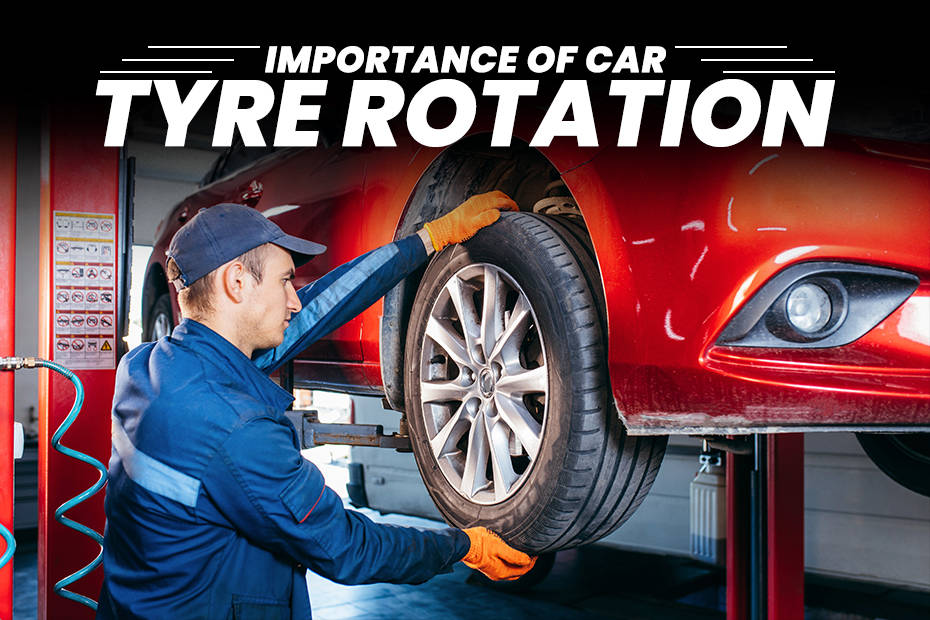8 Reasons Why You Should Rotate Your Car Tyres Regularly
Modified On Jul 12, 2024 03:09 PM By CarDekho
- Write a comment
For optimal performance, safety, and cost-effectiveness, incorporate regular tyre rotation into your vehicle's maintenance routine

Often overlooked yet crucial for safety and performance, vehicle tyres steadily wear down with use. To extend their lifespan and optimise their effectiveness, regular tyre rotation is essential. Tyre maintenance is crucial and one of the easiest yet most impactful practices for which is tyre rotation. This simple procedure helps distribute wear more evenly across all four tyres.
During tyre rotation, the positions of the tyres are switched to distribute wear more evenly. The rear tyres are moved to the front position (but remain on the same side of the car). The front tyres are then moved to the back position, but diagonally. This means the left front tyre becomes the right rear tyre, and the right front tyre becomes the left rear tyre.Here are eight reasons tyre rotation should be a regular part of your car care routine.
1. Save Money with Even Tyre Wear:

Due to weight distribution and driving habits, tyres undergo wear and tear unevenly. Front tyres, for example, often handle more weight and turning stress because of the engine at the front. Interchanging the front and rear tyre positions regularly helps distribute this wear more evenly across all four tyres, extending their lifespan. This translates to significant savings as you won't need to replace them as frequently.
2. Grip That Results in Improved Traction and Performance

Tyres with worn-down treads have less traction, which can affect handling and braking, especially in bad weather. Regular rotation ensures all four tyres share the workload, resulting in improved overall performance and better control of your vehicle.
Also Check Out: Uttar Pradesh Makes Strong Hybrids More Affordable, Here Are The Top 5 Options In India
3. Better Fuel Efficiency Means More Savings

Tyre rotation can save you money at the pump. Unevenly worn tyres can increase rolling resistance, which means your car needs to work harder to maintain speed. Tyre rotation carried out regularly helps in reducing rolling resistance and improving fuel economy.
4. Enhanced Ride Comfort

Unevenly worn tyres can cause vibrations and an uncomfortable ride. Rotating tyres helps balance them, ensuring a smoother and more enjoyable driving experience for you and your passengers. Less bounce translates to a better ride experience and less potential car sickness for the passengers at the back.
5. Identifying Wheel Alignment Issues at an Early Stage

Proper alignment is essential for even tyre wear and stable handling. Regular tyre rotation can help identify alignment issues at an early stage. Identifying these problems early can prevent further damage to your tyres and suspension components, saving you money on repairs down the line.
6. Regular Tyre Rotation Can Extend Tyre Warranty Coverage

Many tyre manufacturers offer warranties based on mileage. However, to ensure you can claim replacements if needed, you must follow their maintenance recommendations, which often include regular rotation. Following these simple steps helps you maximise the value of your tyre warranty and get the most out of your investment.
7. Reduces Risk of Accidents

Unevenly worn tyres with reduced tread depth can significantly impact your car's ability to grip the road. This can increase the risk of accidents, especially in slippery conditions. Regular rotation helps maintain tyre integrity, reducing the likelihood of dangerous blowouts and sudden tyre failures. Safety should always be your top priority, and tyre rotation helps in keeping you and your loved ones safe on the road.
8. Predictable Handling: Consistent Performance

Regular tyre rotation contributes to better stability and predictability during cornering and lane changes. You'll feel more confident behind the wheel knowing your car will respond the way you expect it to.
Bonus Tip: Choosing the Right Rotation Pattern

There are different tyre rotation patterns for various vehicle types (front-wheel drive, rear-wheel drive, and all-wheel drive). Consult your car's owner's manual for the recommended pattern for your specific vehicle. Some common patterns include forward cross, X-pattern, and four-wheel drive pattern.Aggressive driving styles and performance tyres, while offering superior handling, can accelerate this wear. To extend their lifespan and optimise their effectiveness, regular tyre rotation is typically recommended by manufacturers at intervals between 5,000 and 8,000 kilometres.
There are different tyre rotation patterns for various vehicle drivetrains (front-wheel drive, rear-wheel drive, and all-wheel drive).While adhering to the manufacturer's recommended rotation schedule is a good starting point, there are situations that might indicate a need for earlier intervention. Visible signs of uneven tread wear on any of your tyres can be significant. Additionally, vibrations while driving, particularly at higher speeds, can suggest an imbalance or uneven wear that warrants a prompt tyre rotation.
Investing in Your Car's Health
Tyre rotation is a simple and cost-effective way to extend the life of your tyres, improve your car's performance, and most importantly, ensure your safety on the road. Think of it as a small investment with big benefits. Schedule regular tyre rotations with a trusted mechanic and enjoy a smoother, safer, and more economical driving experience.
1 out of 1 found this helpful













